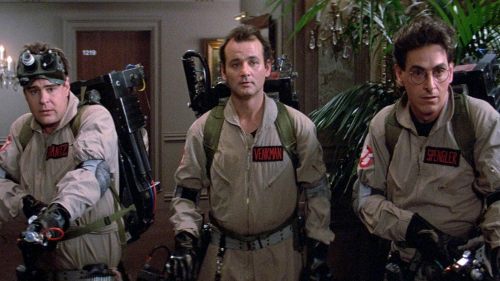Collins’ Crypt: Why I’ll Never Get Sick Of BLACK CHRISTMAS
I recently argued with my wife over whether or not she had seen a certain movie (Troy, for the record); she swore she hadn't but I knew she did because we saw it together at the Danvers multiplex in the summer of 2004. This is not a movie I think about all that often (though I did enjoy it), but I can still remember when I saw it, just as I can pretty much every movie to some extent. Maybe not exact dates, but "fall of ____" or "right around my 15th birthday" or something along those lines tends to be as vague as I get, because it's just one of those things I remember, just as my niece's exact birthday is something I can never, ever remember (near the end of October, or, right around when I saw the Texas Chainsaw remake). But for the life of me I can't recall when I first saw the original Black Christmas*, to the extent where even though I'm pretty sure I was in high school, I'm not 100% on it - did I wait until college? I honestly don't know for sure. It was on VHS, but beyond that I am at a loss - I can't even remember if it was rented or borrowed (another thing I'm pretty good at recalling, despite it being entirely useless information).
But as I pored over Scream Factory's new Blu-ray, which hits next week, I realized at least part of the reason why this might be the case - the movie itself is kind of vague and uncertain. It neither starts nor ends in a traditional way; when the film opens the girls of Pi Kappa Sig have already been subject to creepy phone calls (and know of a girl who was attacked), denying the audience that initial scare that the protagonists must have felt when they first heard the stranger's voice. Instead, it's a low-key in medias res kinda deal; the phone rings and Jess (Olivia Hussey) tells us that it's that creepy caller "again", putting us a step or two behind our characters - unusual for a horror film where the audience is usually privy to information the characters do not yet possess. And (spoiler for 42-year-old movie ahead) it ends without any definitive answers - the guy we thought was the killer is dead, yet the phone begins to ring yet again. It gives the film an almost dream-like quality - no real beginning or end, just a slice of an ongoing, unending story.
Luckily, the film itself doesn't employ "dream logic" or anything like that - this isn't a David Lynchian slasher film. But it IS much (intentionally) funnier than the average slasher, giving the film a warmth that I think is one of the key ingredients to its continued success. Director Bob Clark would go on to make mostly comedies (plans to return to the horror genre with a remake of his own Children Shouldn't Play With Dead Things were cut short when he was killed by a drunk driver in 2007), so it's not much of a surprise when the film detours into comedic material, mostly courtesy of Mrs. Mac (Marian Waldman) and the idiot cop Nash (Doug McGrath). Mrs. Mac is the house mother who hides booze in nearly every nook and cranny the gigantic sorority house has to offer, and her failed attempts to cover up risque material in the house when Clare's father comes to look around for her are comedic gold. As for Nash, he's the butt of the movie's most memorable joke ("Fellatio! It's the new exchange."), and even finds a way to score laughs during the tense scenes - it's actually thanks to him that Jess gets to find out that the calls are "coming from inside the house!", a moment that's played for maximum scares in the ripoff (When A Stranger Calls) but as another "oh Nash you moron" moment here. You'd never call the film a horror comedy, but rather a horror movie that's also genuinely funny at times, which is an important distinction.

And whether they're funny or not, the characters are all fairly memorable. As a proto-slasher you can't accuse it of trying to improve on any of the other masked killer movies, since they didn't exist yet - so we can instead look at it and find it a shame that so many of the films that came in its wake didn't make as much effort when it came to the character work. Even the girl who dies early on (Clare, she of the plastic bagged head) gets more dimension than some of the teens who made it through two acts of a Friday the 13th sequel, and in repeat viewings we can actually feel sad for her when she dies thanks to being rounded out even more by the presence of the character's father (James Edmond, the film's unheralded MVP) and Chris, her boyfriend played by Art Hindle. What could have easily been two nothing characters (or they could have been combined - two people looking for someone we know is dead is a bit unusual) instead produced fan favorites, who are mostly left out of red herring status (the dad more than Chris) and help show the audience that Clare had a real life before the movie began. So more than just about any other "first victim", it's a bummer that she's dead (and stuck up in the attic for who knows how long, since the cops can't be bothered to check it).
The girls that actually live for a while fare even better. Jess has one of the more complicated backstories ever afforded a slasher film, in that she's pregnant but wants an abortion - which her boyfriend Peter (Keir Dullea) angrily opposes, which is the reverse of what you'd usually expect, if the topic came up at all. Pregnant slasher victims/heroines are rare, for the obvious reason - these films are supposed to be kind of fun and there's nothing fun about a fetus offed as a "bonus kill" (for example: Debbie in Friday the 13th Part 3), but a pregnant heroine goes against the "has to be a virgin" rule. Again, this being four years before even Halloween, let alone the imitators, Black Christmas doesn't have to adhere to or circumvent such rules to be clever - they didn't exist yet. So our unmarried heroine can be knocked up and the nice girl (Phyllis, played by Andrea Martin) who didn't do anything wrong can get unceremoniously offed (we know she's dead, but it's off-screen and her corpse doesn't tell us much), because there's no tradition to uphold or betray. It's just how it IS, sans commentary. As for Margot Kidder's Barb, she's the most typical slasher character - promiscuous and oft-drunk, but Kidder's performance elevates Barb into an almost tragic figure. When Phyllis tells her to go to bed and sleep off her drunkenness, Kidder's fallen face is legitimately heartbreaking - and not just because she stabbed to death by a glass unicorn as a result.
Speaking of which, there really isn't much of a body count in the movie at all. Billy kills five or six (the girl in the park is up for debate) total in the film, and only three are on-screen. Jess adds to it by taking out Peter with her trusty poker, but that's off-screen too - the movie actually makes Halloween look overly violent in comparison. But thanks to the pre-existing phone call subplot, it gets to be creepy right from the start, and Clark (and screenwriter Roy Moore, who sadly passed away in the '80s and thus never got to see the film go from obscure horror flick to venerated classic) goes with the "audience knows about the bomb under the table" approach by letting us know Billy is in the house long before any of the other characters do. The film has a fairly brief timeframe (roughly 24 hours), so we can be fairly sure Billy never leaves the house once he's in there, making every scene a bit unnerving whether there's a phone call or other scary thing going on or not - he could strike at any moment.

However, nothing is as creepy or terrifying as the fact that we simply have no idea about so many things in the movie. Did Billy attack that girl that they mention, or kill young Janice in the park? We have no idea for sure - we can ASSUME as much (Janice more than the rape, since the latter doesn't seem his MO), but there's nothing in the movie to definitively answer it one way or the other. And is Billy a character we meet under other circumstances, or a complete enigma? As I mentioned, Peter is the most likely suspect throughout the film, but it's NOT him, and Clark refused to shoot a scene the studio requested that would peg Chris as the killer (a good thing, too - since he is accounted for during Mrs. Mac's murder, it'd create a giant plot hole). In fact, the compressed timeframe pretty much cancels out everyone else in the movie, since you know that they're not in the house when Billy IS, so we can safely assume that if Billy IS a character we've met in the film, Clark had to be cheating to make it work. Not that that sort of thing would be unheard of for whodunit horror movies (X-Ray, aka Hospital Massacre, is the most offensive - at one point the killer chases a character who later turns out to be the killer), but the film is too classy to stoop to that sort of thing.
No, I truly believe that we're not meant to figure anything out, but that's yet another reason the movie works so well - we can't help but try. I watch the film every year at the New Beverly (or at home if I can't make the screening, though I usually make sure I have that night off to ensure I don't have to "settle" for a home viewing**), and damned if I don't feel like there might be some little clue I never considered that will point to a culprit. It's the same thing that fascinates us about the Zodiac killer and reruns of Unsolved Mysteries, without that twinge of exploitative guilt of finding the entertainment value in real life tragedies. Filling in the blanks is always part of what makes a successful horror movie (the old "it's what you don't see that makes it scary" philosophy), and Black Christmas gives us plenty of them. The Blu-ray will take you at least ten hours to go through including the commentaries, but despite all that information you'll never get any closer to figuring it out (though in one interview Clark does say it's "all there", or something to that effect). There are a few deleted scenes that won't help you, and even an in-character commentary by Billy (actor Nick Mancuso) that sheds exactly zero light on who Agnes is or what the hell he's ever talking about (I assume; I actually couldn't make myself sit through the entire thing, as it's obnoxious as all hell). In an era where everything gets over-explained and all the mystique is washed away through sequels and prequels and whatever else comes to greedy producers' minds, I love that Black Christmas' mysteries will forever remain intact. At least until I figure it out on my next viewing.
* I obviously remember the exact date I saw the remake - December 25th, 2006 (at the AMC Burbank 16). Which means my first defense was around December 27th, 2006.
** Home viewings are no longer as dire thanks to this new Blu-ray. It won't make your head spin or anything, but it's the best the film's ever looked on a home format, and probably the best it ever WILL look - the original elements are just not up to the same standards we've been spoiled by on other legacy releases, and thus there's only so much they can do to make it shine. If you want proof, the new Blu even includes the previous transfer on a second disc so you can compare how much better the new one looks.



